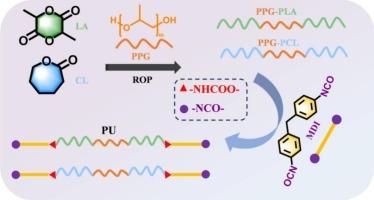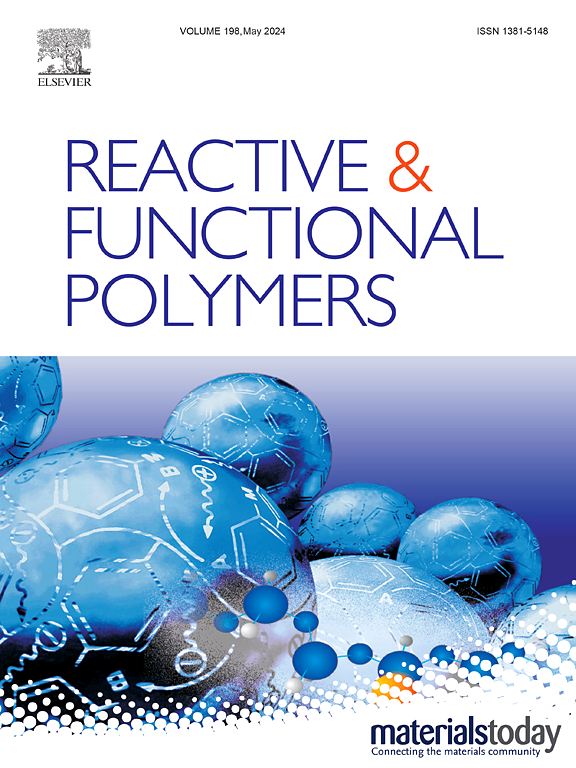Facile synthesis of polyester-polyether block copolyols for the sustainable high-performance polyurethane reactive hot melt adhesives
IF 4.5
3区 工程技术
Q1 CHEMISTRY, APPLIED
引用次数: 0
Abstract
The presence of polyols with both polyester and polyether structures in polyurethane enhances bonding strength and facilitates easy curing. In this study, polyester-polyether block polyols with varying molecular weights (2500–3500) were synthesized through ring-opening polymerization (ROP) using l-lactide (LA) and ε-Caprolactone (CL). The chemical structure of the polyols was characterized using 1H nuclear magnetic resonance (1H NMR), Fourier transform infrared (FTIR), and gel permeation chromatography (GPC). Differential scanning calorimetry (DSC) and polarized optical microscopy (POM) were employed to examine the crystalline morphology of the polyols. Subsequently, the synthesized polyols were combined with 4,4′-diphenylmethane diisocyanate (MDI) and other additives to prepare polyurethane reactive hot melt adhesives. It was observed that, in PCL-based polyurethane reactive hot melt adhesives, increasing the molecular weight of the polyols resulted in improved crystalline morphology, increased lap shear strength and tensile strength, and enhanced thermal stability. On the other hand, PLA-based polyurethane reactive hot melt adhesives exhibited low bonding strength and lacked practical application value due to the poor toughness of PLA. Interestingly, the bonding strength and tensile strength of PLA-based polyurethane reactive hot melt adhesives improved when physically blended with PCL-based polyurethane reactive hot melt adhesives. These polyols offer a novel approach for utilizing LA and CL in adhesive applications.

用于可持续高性能聚氨酯反应型热熔胶的聚酯-聚醚嵌段多元醇的简易合成
聚氨酯中同时含有聚酯和聚醚结构的多元醇可增强粘合强度,并便于固化。在这项研究中,使用 l-内酯(LA)和ε-己内酯(CL)通过开环聚合(ROP)合成了不同分子量(2500-3500)的聚酯-聚醚嵌段多元醇。使用 1H 核磁共振(1H NMR)、傅立叶变换红外(FTIR)和凝胶渗透色谱(GPC)对多元醇的化学结构进行了表征。差示扫描量热法(DSC)和偏光光学显微镜(POM)用于检查多元醇的结晶形态。随后,将合成的多元醇与 4,4′-二苯基甲烷二异氰酸酯(MDI)和其他添加剂结合,制备聚氨酯反应型热熔胶。据观察,在以 PCL 为基础的聚氨酯反应型热熔粘合剂中,增加多元醇的分子量可改善结晶形态,提高搭接剪切强度和拉伸强度,并增强热稳定性。另一方面,聚乳酸基聚氨酯反应型热熔胶的粘合强度较低,并且由于聚乳酸的韧性较差而缺乏实际应用价值。有趣的是,当聚乳酸基聚氨酯反应型热熔胶与 PCL 基聚氨酯反应型热熔胶物理混合时,聚乳酸基聚氨酯反应型热熔胶的粘合强度和拉伸强度都有所提高。这些多元醇为在粘合剂应用中使用 LA 和 CL 提供了一种新方法。
本文章由计算机程序翻译,如有差异,请以英文原文为准。
求助全文
约1分钟内获得全文
求助全文
来源期刊

Reactive & Functional Polymers
工程技术-高分子科学
CiteScore
8.90
自引率
5.90%
发文量
259
审稿时长
27 days
期刊介绍:
Reactive & Functional Polymers provides a forum to disseminate original ideas, concepts and developments in the science and technology of polymers with functional groups, which impart specific chemical reactivity or physical, chemical, structural, biological, and pharmacological functionality. The scope covers organic polymers, acting for instance as reagents, catalysts, templates, ion-exchangers, selective sorbents, chelating or antimicrobial agents, drug carriers, sensors, membranes, and hydrogels. This also includes reactive cross-linkable prepolymers and high-performance thermosetting polymers, natural or degradable polymers, conducting polymers, and porous polymers.
Original research articles must contain thorough molecular and material characterization data on synthesis of the above polymers in combination with their applications. Applications include but are not limited to catalysis, water or effluent treatment, separations and recovery, electronics and information storage, energy conversion, encapsulation, or adhesion.
 求助内容:
求助内容: 应助结果提醒方式:
应助结果提醒方式:


